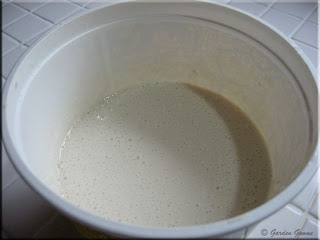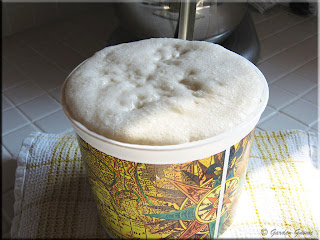I've talked a discussed sourdough breads that rely on sourdough starters. The most common questions that arise with sourdough breads is how to create and maintain the starter. The starter is critical to a good sourdough bread! Essentially the starter is nothing more than equal amounts of flour mixed with water then set in aside at room temperature to collect the wild yeast. If you have made a lot of bread there will be a lot of wild yeast in your kitchen. If you don't it will take longer for your mixture to become inoculated with wild yeast.
There are two warnings your must head when using sourdough starter. First, you cannot make yogurt and keep the starter on the counter. The reason is the bacteria that causes the yogurt to yog (get thick) competes with the yeast. This is why you eat yogurt if you have bacterial stomach or gastrointestinal problems such as thrush. The yeast from the yogurt kills off the bacteria. Well this principle demonstrates why yogurt making and sourdough starter cannot co-exist in the kitchen. Either or both will fail. Second, despite all good maintenance your starter may get contaminated. If at any time your starter does not look right, discard it and start again. For some, fruit flies (Drosophilla melanogaster) that feed on the yeast not actual fruit can be a problem so either protect your starting using cheese cloth or use your starter mainly through the winter months when these insects are less likely to be present.
 Before
Before
Sourdough starter requires regular maintenance normally referred to as feeding. That is because the yeast population that is doubling exponentially in the starter uses up the food resources. In this case the food resource is flour. Once the food resource is depleted the yeast population will begin to die off. You don't want that because the starter will no longer have leaving power. To prevent yeast die off from happening a portion of the starter is removed and either used for a second batch of starter or discarded. An equal amount to what was removed is then added in the form of half flour and half water, mixed well into the remaining starter. A plastic container is preferred because any starter on the sides can easily be scraped back into the main starter. The starter must be fed before making bread.
Pictured is the starter just after feeding. As you can see it immediate reacts by showing signs of bubbling. If your starter does not do this discard it and start again. You should smell a deep, aromatic, yeast smell to the starter that is rather tangy. If you notice any other smell, discard the starter and start again. If you notice any peculiar colour that indicates spoilage, discard the starter. Note: It is normal for a liquid to form on top of the starter. This is called hooch. The hooch should be stirred back into the starter before feeding.
 After
After
Many sourdough recipes tell you to let the starter get spongy. Well that can be a bit confusing to those new to making sourdough breads. A sponge is just that. The starter takes on the appearance of a sponge with a lot of air pockets and somewhat springy texture. Think of it as an edible form os spray foam insulation that expands after spraying! The sponge will be light and airy while more than doubling it's size so be sure to use a large container.
If you want the sponge to form quicker or if your kitchen is cold heat a grain pack in the microwave oven. Cover it with a tea towel then set the starter on top. This will provide enough warmth for the starter to form a sponge. When measuring the sponge, spoon it into a measuring cup and always warm any liquids going into the bread dough to allow the wild yeast to continue multiplying giving that lovely sourdough flavour that just can't be beat!






2 food lovers commented:
You are welcome Danielle.
Thanks for visiting Tessa. I'm glad you are enjoying my blog.
Post a Comment